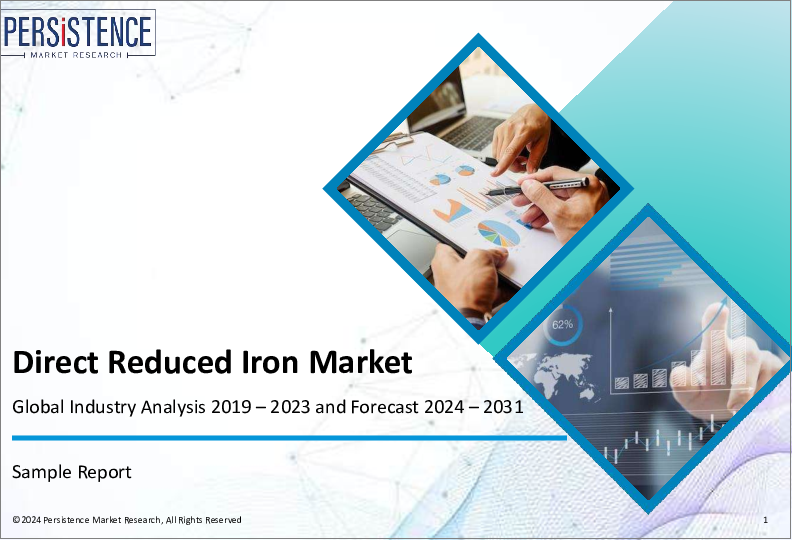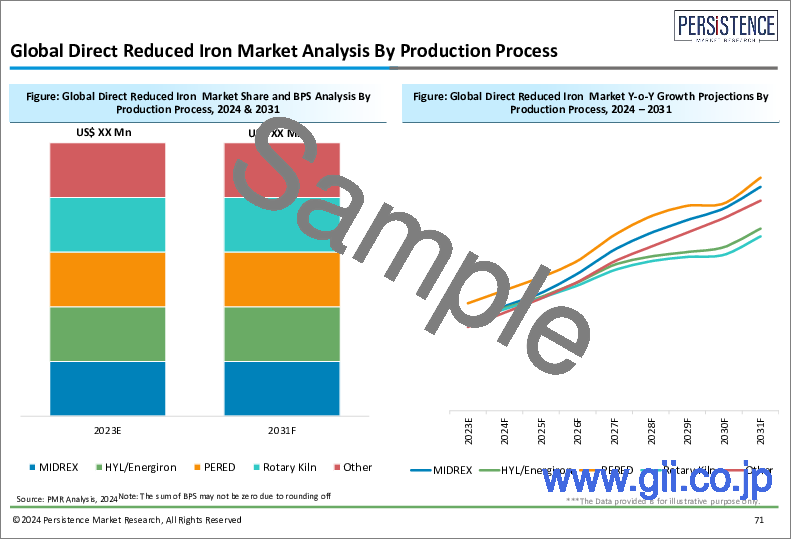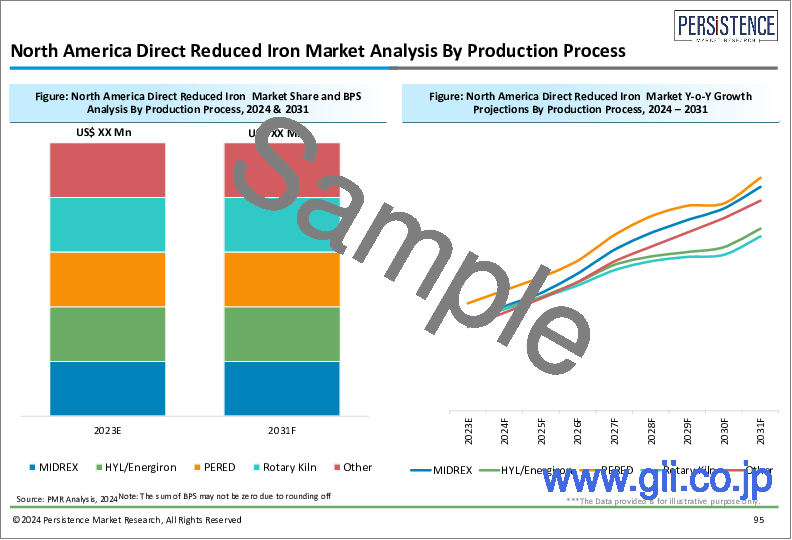|
|
市場調査レポート
商品コード
1555657
直接還元鉄市場:世界の産業分析、規模、シェア、成長、動向、予測、2024年~2031年Direct Reduced Iron Market: Global Industry Analysis, Size, Share, Growth, Trends, and Forecast, 2024-2031 |
||||||
カスタマイズ可能
|
|||||||
| 直接還元鉄市場:世界の産業分析、規模、シェア、成長、動向、予測、2024年~2031年 |
|
出版日: 2024年09月12日
発行: Persistence Market Research
ページ情報: 英文 188 Pages
納期: 2~5営業日
|
- 全表示
- 概要
- 目次
Persistence Market Researchはこのほど、直接還元鉄(DRI)の世界市場に関する包括的なレポートを発表しました。当レポートでは、促進要因・動向・機会・課題を含む重要な市場力学を徹底的に評価し、市場構造に関する詳細な洞察を提供しています。
主要な洞察
- 直接還元鉄の市場規模(2024年):421億米ドル
- 予測市場金額(2031年):729億米ドル
- 世界市場成長率(CAGR 2024年~2031年):8.2%
直接還元鉄市場 - レポート範囲:
直接還元鉄(DRI)はスポンジ鉄としても知られ、鉄鉱石を溶融せずに固体のまま還元して製造される鉄の一形態です。このプロセスは、従来の高炉に比べて炭素排出量が少ないため、鉄鋼生産、特に電気アーク炉(EAF)で広く使用されています。直接還元鉄市場は、鉄鋼メーカー、鋳物工場、自動車・建設業界を含む様々なエンドユーザーにサービスを提供しており、熱間ブリケット鉄(HBI)、コールドDRI、塊状鉄鉱石など様々なタイプを提供しています。
市場成長の促進要因:
世界の直接還元鉄市場は、新興国における鉄鋼需要の増加や、製鉄における炭素排出量削減の重視の高まりなど、いくつかの重要な要因によって牽引されています。環境規制が強化されるにつれ、DRIを使用するような環境に優しい鉄鋼生産方法へのシフトが加速しています。DRIを主原料とする電気アーク炉の採用は、市場成長をさらに加速します。さらに、水素ベースの還元プロセスの開発など、DRI技術の進歩は効率性と持続可能性の向上をもたらし、市場の拡大に寄与しています。
市場の抑制要因:
有望な成長展望にもかかわらず、直接還元鉄市場は、原料の高コストと還元プロセスにおけるエネルギー消費に関連する課題に直面しています。DRI生産に不可欠な高品質の鉄鉱石と天然ガスの入手は、これらの資源が不足している地域では制約となります。さらに、鉄鋼需要と価格の変動は、特に新興経済諸国ではDRI市場に影響を与える可能性があります。こうした課題に対処するには、生産プロセスを最適化し、不安定な原料市場への依存を減らすための研究開発への投資が必要です。
市場機会:
直接還元鉄市場は、電気アーク炉の採用拡大と持続可能な鉄鋼生産への世界的シフトを原動力とする大きな成長機会を示しています。水素をベースとするDRI生産の開発は、製鉄における炭素排出を削減する画期的な可能性を提供します。さらに、鉄ベースの化学薬品や粉末の生産など、鉄鋼以外の産業におけるDRIの利用拡大が市場範囲を広げています。戦略的提携、再生可能エネルギー統合への投資、費用対効果の高いDRIソリューションの採用は、新たな機会を活用し、進化するDRIの状況で市場のリーダーシップを維持するために不可欠です。
本レポートで扱う主要な質問
- 世界の直接還元鉄市場の成長を促進する主要な要因は何か?
- さまざまなエンドユーザー産業で支持を集めているDRI製品のタイプは?
- 技術進歩は直接還元鉄市場の競合情勢をどのように変えているのか?
- 直接還元鉄市場に貢献している主要企業はどこか、また市場の関連性を維持するためにどのような戦略を採用しているか?
- 世界の直接還元鉄市場の新たな動向と将来性は?
目次
第1章 エグゼクティブサマリー
第2章 市場概要
- 市場の範囲と定義
- 市場力学
- 促進要因
- 抑制要因
- 機会
- 課題
- 主要な動向
- マクロ経済要因
- 世界のセクター別展望
- 世界のGDP成長展望
- 世界の鉄鋼産業の展望
- COVID-19の影響分析
- 予測要因 - 関連性と影響
第3章 付加価値の洞察
- プロセスタイプの採用分析
- プロセスタイプの評価
- 規制状況
- バリューチェーン分析
- 原材料サプライヤー一覧
- メーカー一覧
- 販売代理店一覧
- 収益性分析
- 主要な取引と合併
- PESTLE分析
- ポーターのファイブフォース分析
- 地政学的緊張:市場への影響
第4章 価格動向分析、2019年~2031年
- 主要なハイライト
- プロセスタイプの価格に影響を与える主要な要因
- 製品別の価格分析
- 地域別の価格とプロセスタイプの好み
第5章 世界の直接還元鉄市場の展望:実績(2019年~2023年)と予測(2024年~2031年)
- 主要なハイライト
- 市場数量(単位)予測
- 市場規模(10億米ドル)と前年比成長率
- 絶対額の機会
- 市場規模(10億米ドル)の分析と予測
- 過去の市場規模(10億米ドル)分析、2019年~2023年
- 現在の市場規模(10億米ドル)の分析と予測、2024年~2031年
- 世界の直接還元鉄市場の展望:プロセスタイプ
- イントロダクション / 主要な調査結果
- 過去の市場規模(10億米ドル)分析、プロセスタイプ別、2019年~2023年
- 現在の市場規模(10億米ドル)予測、プロセスタイプ別、2024年~2031年
- ミドレックス
- ヒュル / エナジオン
- ペレド
- ロータリーキン
- 市場の魅力分析:プロセスタイプ
- 世界の直接還元鉄市場の展望:製品タイプ
- イントロダクション / 主要な調査結果
- 過去の市場規模(10億米ドル)分析、製品タイプ別、2019年~2023年
- 現在の市場規模(10億米ドル)分析と予測、製品タイプ別、2024年~2031年
- HBI
- HDRI
- CDRI
- 市場の魅力分析:製品タイプ
第6章 世界の直接還元鉄市場の展望:地域
- 主要なハイライト
- 過去の市場規模(10億米ドル)の分析、地域別、2019年~2023年
- 現在の市場規模(10億米ドル)の予測、地域別、2024年~2031年
- 北米
- 欧州
- 東アジア
- 南アジア・オセアニア
- ラテンアメリカ
- 中東・アフリカ
- 市場の魅力分析:地域
第7章 北米直接還元鉄市場の展望:実績(2019年~2023年)と予測(2024年~2031年)
第8章 欧州直接還元鉄市場の展望:実績(2019年~2023年)と予測(2024年~2031年)
第9章 東アジアの直接還元鉄市場の展望:実績(2019年~2023年)と予測(2024年~2031年)
第10章 南アジア・オセアニアの直接還元鉄市場の展望:実績(2019年~2023年)と予測(2024年~2031年)
第11章 ラテンアメリカの直接還元鉄市場の展望:実績(2019年~2023年)と予測(2024年~2031年)
第12章 中東・アフリカの直接還元鉄市場の展望:実績(2019年~2023年)と予測(2024年~2031年)
第13章 競合情勢
- 市場シェア分析、2023年
- 市場構造
- 競合激化マップ:市場別
- 競合ダッシュボード
- 企業プロファイル(詳細 - 概要、財務、戦略、最近の動向)
- ArcelorMittal SA
- Midrex Technologies Inc.
- HYL Technologies
- Kobe Steel Ltd.
- Tata Steel Ltd.
- ThyssenKrupp AG
- Qatar Steel
- Khouzestan Steel Company
- Jindal Steel &Power Ltd
第14章 付録
- 調査手法
- 調査の前提条件
- 頭字語と略語
Persistence Market Research has recently released a comprehensive report on the worldwide market for Direct Reduced Iron (DRI). The report offers a thorough assessment of crucial market dynamics, including drivers, trends, opportunities, and challenges, providing detailed insights into the market structure.
Key Insights:
- Direct Reduced Iron Market Size (2024E): US$42.1 Bn
- Projected Market Value (2031F): US$72.9 Bn
- Global Market Growth Rate (CAGR 2024 to 2031):8.2%
Direct Reduced Iron Market - Report Scope:
Direct Reduced Iron (DRI), also known as sponge iron, is a form of iron produced by reducing iron ore in its solid state without melting. This process is widely used in steel production, particularly in Electric Arc Furnaces (EAFs), due to its lower carbon emissions compared to traditional blast furnaces. The Direct Reduced Iron market serves a variety of end-users, including steel manufacturers, foundries, and the automotive and construction industries, offering various types such as hot-briquetted iron (HBI), cold DRI, and lump iron ore.
Market Growth Drivers:
The global Direct Reduced Iron market is driven by several key factors, including increasing demand for steel in emerging economies and the growing emphasis on reducing carbon emissions in steelmaking. As environmental regulations tighten, the shift toward greener steel production methods, such as using DRI, gains momentum. The adoption of Electric Arc Furnaces, which utilize DRI as a primary feedstock, further accelerates market growth. Additionally, advancements in DRI technology, such as the development of hydrogen-based reduction processes, offer enhanced efficiency and sustainability, contributing to the market's expansion.
Market Restraints:
Despite promising growth prospects, the Direct Reduced Iron market faces challenges related to the high cost of raw materials and energy consumption in the reduction process. The availability of high-quality iron ore and natural gas, essential for DRI production, poses constraints in regions lacking these resources. Additionally, fluctuations in steel demand and prices can impact the DRI market, particularly in developing economies. Addressing these challenges requires investment in research and development to optimize production processes and reduce dependency on volatile raw material markets.
Market Opportunities:
The Direct Reduced Iron market presents significant growth opportunities driven by the increasing adoption of Electric Arc Furnaces and the global shift toward sustainable steel production. The development of hydrogen-based DRI production offers a potential breakthrough in reducing carbon emissions in steelmaking. Furthermore, the expanding use of DRI in non-steel industries, such as the production of iron-based chemicals and powders, broadens the market scope. Strategic collaborations, investments in renewable energy integration, and the introduction of cost-effective DRI solutions are essential to capitalize on emerging opportunities and sustain market leadership in the evolving DRI landscape.
Key Questions Answered in the Report:
- What are the primary factors driving the growth of the Direct Reduced Iron market globally?
- Which types of DRI products are gaining traction in different end-user industries?
- How are technological advancements reshaping the competitive landscape of the Direct Reduced Iron market?
- Who are the key players contributing to the Direct Reduced Iron market, and what strategies are they employing to maintain market relevance?
- What are the emerging trends and future prospects in the global Direct Reduced Iron market?
Competitive Intelligence and Business Strategy:
Leading players in the global Direct Reduced Iron market, including Midrex Technologies, Inc., Tenova HYL, and ArcelorMittal, focus on innovation, process optimization, and strategic partnerships to gain a competitive edge. These companies invest in R&D to develop advanced DRI production technologies, including hydrogen-based processes, which cater to the growing demand for sustainable steel production. Collaborations with steel manufacturers, energy providers, and regulatory agencies facilitate market access and promote the adoption of eco-friendly steelmaking solutions. Moreover, emphasis on cost efficiency, supply chain management, and market expansion into developing regions fosters market growth and strengthens competitive positioning in the dynamic Direct Reduced Iron market.
Key Companies Profiled:
- Midrex Technologies, Inc.
- Tenova HYL
- ArcelorMittal
- Voestalpine AG
- Jindal Steel & Power Ltd.
- Emirates Steel
- Tata Steel
- Nucor Corporation
- Cleveland-Cliffs Inc.
- Qatar Steel
Direct Reduced Irons Industry Segmentation
By Process Type
- MIDREX
- HYL/ ENEGIRON
- PERED
- Rotary Kiln
By Product Type
- HBI
- HDRI
- CDRI
By Region
- North America
- Europe
- East Asia
- South Asia & Pacific
- Latin America
- The Middle East & Africa
Table of Contents
1. Executive Summary
- 1.1. Global Direct Reduced Iron Market Snapshot, 2024-2031
- 1.2. Market Opportunity Assessment, 2024-2031, US$ Mn
- 1.3. Key Market Trends
- 1.4. Future Market Projections
- 1.5. Premium Market Insights
- 1.6. Industry Developments and Key Market Events
- 1.7. PMR Analysis and Recommendations
2. Market Overview
- 2.1. Market Scope and Definition
- 2.2. Market Dynamics
- 2.2.1. Drivers
- 2.2.2. Restraints
- 2.2.3. Opportunity
- 2.2.4. Challenges
- 2.2.5. Key Trends
- 2.3. Macro-Economic Factors
- 2.3.1. Global Sectorial Outlook
- 2.3.2. Global GDP Growth Outlook
- 2.3.3. Global Steel Industry Outlook
- 2.4. COVID-19 Impact Analysis
- 2.5. Forecast Factors - Relevance and Impact
3. Value Added Insights
- 3.1. Process Type Adoption Analysis
- 3.2. Process Type Assessment
- 3.3. Regulatory Landscape
- 3.4. Value Chain Analysis
- 3.4.1. List of Raw Material Supplier
- 3.4.2. List of Manufacturers
- 3.4.3. List of Distributors
- 3.4.4. Profitability Analysis
- 3.5. Key Deals and Mergers
- 3.6. PESTLE Analysis
- 3.7. Porter's Five Force Analysis
- 3.8. Geopolitical Tensions: Market Impact
4. Price Trend Analysis, 2019-2031
- 4.1. Key Highlights
- 4.2. Key Factors Impacting Process Type Prices
- 4.3. Pricing Analysis, By Product
- 4.4. Regional Prices and Process Type Preferences
5. Global Direct Reduced Iron Market Outlook: Historical (2019-2023) and Forecast (2024-2031)
- 5.1. Key Highlights
- 5.1.1. Market Volume (Units) Projections
- 5.1.2. Market Size (US$ Bn) and Y-o-Y Growth
- 5.1.3. Absolute $ Opportunity
- 5.2. Market Size (US$ Bn) Analysis and Forecast
- 5.2.1. Historical Market Size (US$ Bn) Analysis, 2019-2023
- 5.2.2. Current Market Size (US$ Bn) Analysis and Forecast, 2024-2031
- 5.3. Global Direct Reduced Iron Market Outlook: Process Type
- 5.3.1. Introduction / Key Findings
- 5.3.2. Historical Market Size (US$ Bn) Analysis, By Process Type, 2019-2023
- 5.3.3. Current Market Size (US$ Bn) Forecast, By Process Type, 2024-2031
- 5.3.3.1. MIDREX
- 5.3.3.2. HYL/ENERGION
- 5.3.3.3. PERED
- 5.3.3.4. Rotary Kin
- 5.4. Market Attractiveness Analysis: Process Type
- 5.5. Global Direct Reduced Iron Market Outlook: Product Type
- 5.5.1. Introduction / Key Findings
- 5.5.2. Historical Market Size (US$ Bn) Analysis, By Product Type, 2019-2023
- 5.5.3. Current Market Size (US$ Bn) Analysis and Forecast, By Product Type, 2024-2031
- 5.5.3.1. HBI
- 5.5.3.2. HDRI
- 5.5.3.3. CDRI
- 5.6. Market Attractiveness Analysis: Product Type
6. Global Direct Reduced Iron Market Outlook: Region
- 6.1. Key Highlights
- 6.2. Historical Market Size (US$ Bn) Analysis, By Region, 2019-2023
- 6.3. Current Market Size (US$ Bn) Forecast, By Region, 2024-2031
- 6.3.1. North America
- 6.3.2. Europe
- 6.3.3. East Asia
- 6.3.4. South Asia and Oceania
- 6.3.5. Latin America
- 6.3.6. Middle East & Africa
- 6.4. Market Attractiveness Analysis: Region
7. North America Direct Reduced Iron Market Outlook: Historical (2019-2023) and Forecast (2024-2031)
- 7.1. Key Highlights
- 7.2. Pricing Analysis
- 7.3. Historical Market Size (US$ Bn) Analysis, By Market, 2019-2023
- 7.3.1. By Country
- 7.3.2. By Process Type
- 7.3.3. By Product Type
- 7.4. Current Market Size (US$ Bn) Analysis and Forecast, By Country, 2024-2031
- 7.4.1. U.S.
- 7.4.2. Canada
- 7.5. Current Market Size (US$ Bn) Analysis and Forecast, By Process Type, 2024-2031
- 7.5.1. MIDREC
- 7.5.2. HYL/ENERGION
- 7.5.3. PERED
- 7.5.4. Rotary Kin
- 7.6. Current Market Size (US$ Bn) Analysis and Forecast, By Product Type, 2024-2031
- 7.6.1. HBI
- 7.6.2. HDRI
- 7.6.3. CDRI
- 7.7. Market Attractiveness Analysis
8. Europe Direct Reduced Iron Market Outlook: Historical (2019-2023) and Forecast (2024-2031)
- 8.1. Key Highlights
- 8.2. Pricing Analysis
- 8.3. Historical Market Size (US$ Bn) Analysis, By Market, 2019-2023
- 8.3.1. By Country
- 8.3.2. By Process Type
- 8.3.3. By Product Type
- 8.4. Current Market Size (US$ Bn) Analysis and Forecast, By Country, 2024-2031
- 8.4.1. Germany
- 8.4.2. France
- 8.4.3. U.K.
- 8.4.4. Italy
- 8.4.5. Spain
- 8.4.6. Russia
- 8.4.7. Turkey
- 8.4.8. Rest of Europe
- 8.5. Current Market Size (US$ Bn) Analysis and Forecast, By Process Type, 2024-2031
- 8.5.1. MIDREC
- 8.5.2. HYL/ENERGION
- 8.5.3. PERED
- 8.5.4. Rotary Kin
- 8.6. Current Market Size (US$ Bn) Analysis and Forecast, By Product Type, 2024-2031
- 8.6.1. HBI
- 8.6.2. HDRI
- 8.6.3. CDRI
- 8.7. Market Attractiveness Analysis
9. East Asia Direct Reduced Iron Market Outlook: Historical (2019-2023) and Forecast (2024-2031)
- 9.1. Key Highlights
- 9.2. Pricing Analysis
- 9.3. Historical Market Size (US$ Bn) Analysis, By Market, 2019-2023
- 9.3.1. By Country
- 9.3.2. By Process Type
- 9.3.3. By Product Type
- 9.4. Current Market Size (US$ Bn) Analysis and Forecast, By Country, 2024-2031
- 9.4.1. China
- 9.4.2. Japan
- 9.4.3. South Korea
- 9.5. Current Market Size (US$ Bn) Analysis and Forecast, By Process Type, 2024-2031
- 9.5.1. MIDREC
- 9.5.2. HYL/ENERGION
- 9.5.3. PERED
- 9.5.4. Rotary Kin
- 9.6. Current Market Size (US$ Bn) Analysis and Forecast, By Product Type, 2024-2031
- 9.6.1. HBI
- 9.6.2. HDRI
- 9.6.3. CDRI
- 9.7. Market Attractiveness Analysis
10. South Asia & Oceania Direct Reduced Iron Market Outlook: Historical (2019-2023) and Forecast (2024-2031)
- 10.1. Key Highlights
- 10.2. Pricing Analysis
- 10.3. Historical Market Size (US$ Bn) Analysis, By Market, 2019-2023
- 10.3.1. By Country
- 10.3.2. By Process Type
- 10.3.3. By Product Type
- 10.4. Current Market Size (US$ Bn) Analysis and Forecast, By Country, 2024-2031
- 10.4.1. India
- 10.4.2. Southeast Asia
- 10.4.3. ANZ
- 10.4.4. Rest of South Asia & Oceania
- 10.5. Current Market Size (US$ Bn) Analysis and Forecast, By Process Type, 2024-2031
- 10.5.1. MIDREC
- 10.5.2. HYL/ENERGION
- 10.5.3. PERED
- 10.5.4. Rotary Kin
- 10.6. Current Market Size (US$ Bn) Analysis and Forecast, By Product Type, 2024-2031
- 10.6.1. HBI
- 10.6.2. HDRI
- 10.6.3. CDRI
- 10.7. Market Attractiveness Analysis
11. Latin America Direct Reduced Iron Market Outlook: Historical (2019-2023) and Forecast (2024-2031)
- 11.1. Key Highlights
- 11.2. Pricing Analysis
- 11.3. Historical Market Size (US$ Bn) Analysis, By Market, 2019-2023
- 11.3.1. By Country
- 11.3.2. By Process Type
- 11.3.3. By Product Type
- 11.4. Current Market Size (US$ Bn) Analysis and Forecast, By Country, 2024-2031
- 11.4.1. Brazil
- 11.4.2. Mexico
- 11.4.3. Rest of Latin America
- 11.5. Current Market Size (US$ Bn) Analysis and Forecast, By Process Type, 2024-2031
- 11.5.1. MIDREC
- 11.5.2. HYL/ENERGION
- 11.5.3. PERED
- 11.5.4. Rotary Kin
- 11.6. Current Market Size (US$ Bn) Analysis and Forecast, By Product Type, 2024-2031
- 11.6.1. HBI
- 11.6.2. HDRI
- 11.6.3. CDRI
- 11.7. Market Attractiveness Analysis
12. Middle East & Africa Direct Reduced Iron Market Outlook: Historical (2019-2023) and Forecast (2024-2031)
- 12.1. Key Highlights
- 12.2. Pricing Analysis
- 12.3. Historical Market Size (US$ Bn) Analysis, By Market, 2019-2023
- 12.3.1. By Country
- 12.3.2. By Process Type
- 12.3.3. By Product Type
- 12.4. Current Market Size (US$ Bn) Analysis and Forecast, By Country, 2024-2031
- 12.4.1. GCC Countries
- 12.4.2. Egypt
- 12.4.3. South Africa
- 12.4.4. Northern Africa
- 12.4.5. Rest of Middle East & Africa
- 12.5. Current Market Size (US$ Bn) Analysis and Forecast, By Process Type, 2024-2031
- 12.5.1. MIDREC
- 12.5.2. HYL/ENERGION
- 12.5.3. PERED
- 12.5.4. Rotary Kin
- 12.6. Current Market Size (US$ Bn) Analysis and Forecast, By Product Type, 2024-2031
- 12.6.1. HBI
- 12.6.2. HDRI
- 12.6.3. CDRI
- 12.7. Market Attractiveness Analysis
13. Competition Landscape
- 13.1. Market Share Analysis, 2023
- 13.2. Market Structure
- 13.2.1. Competition Intensity Mapping By Market
- 13.2.2. Competition Dashboard
- 13.3. Company Profiles (Details - Overview, Financials, Strategy, Recent Developments)
- 13.3.1. ArcelorMittal S.A.
- 13.3.1.1. Overview
- 13.3.1.2. Segments and Products
- 13.3.1.3. Key Financials
- 13.3.1.4. Market Developments
- 13.3.1.5. Market Strategy
- 13.3.2. Midrex Technologies Inc.
- 13.3.3. HYL Technologies
- 13.3.4. Kobe Steel Ltd.
- 13.3.5. Tata Steel Ltd.
- 13.3.6. ThyssenKrupp AG
- 13.3.7. Qatar Steel
- 13.3.8. Khouzestan Steel Company
- 13.3.9. Jindal Steel & Power Ltd
- 13.3.1. ArcelorMittal S.A.
14. Appendix
- 14.1. Research Methodology
- 14.2. Research Assumptions
- 14.3. Acronyms and Abbreviations





